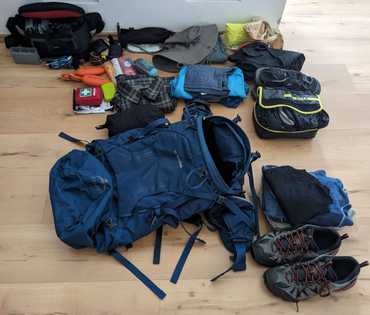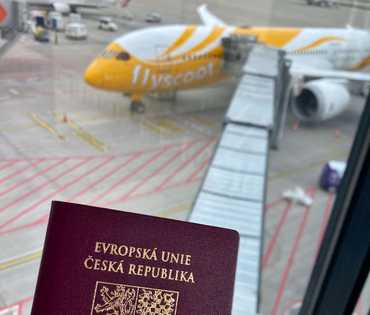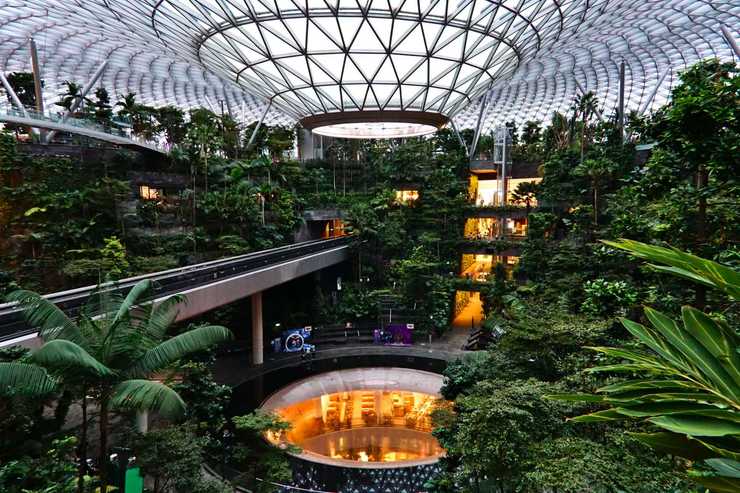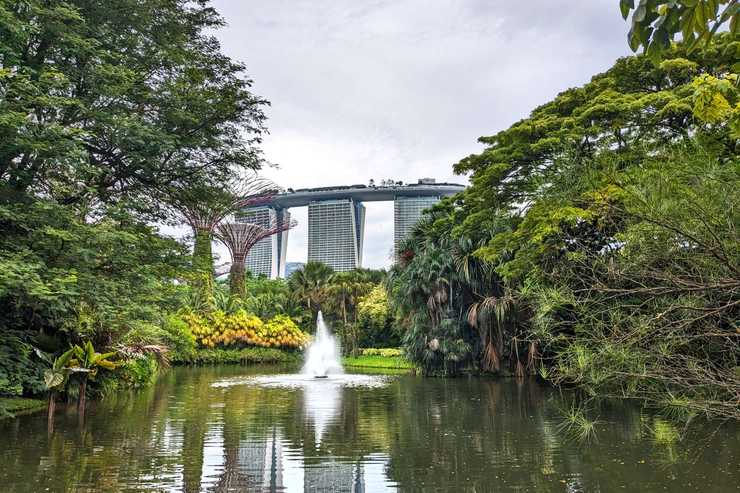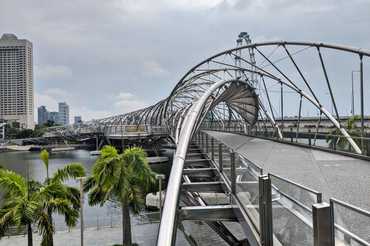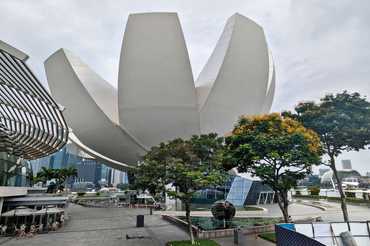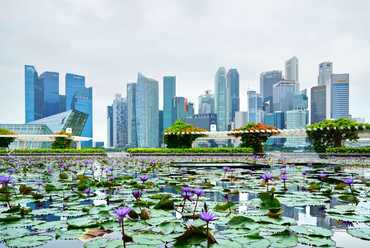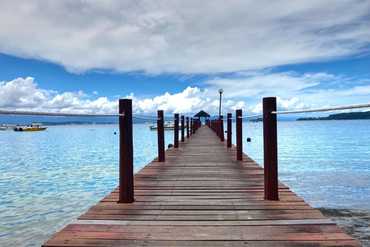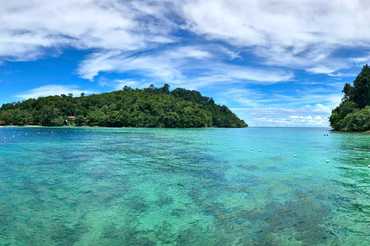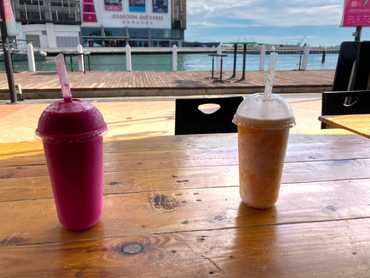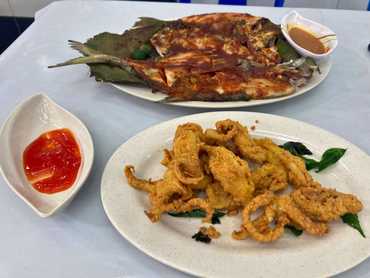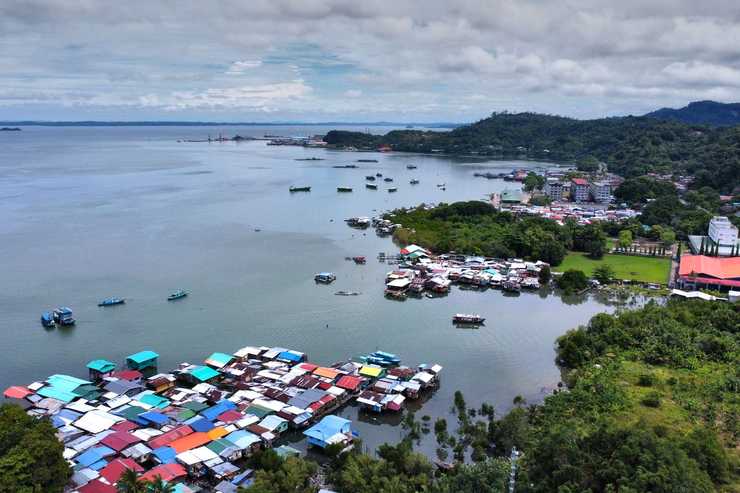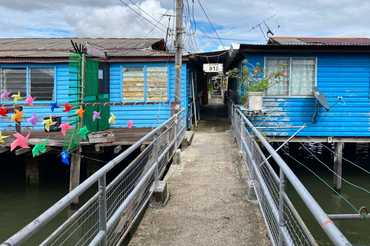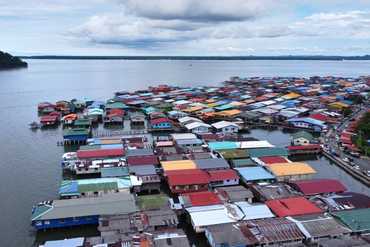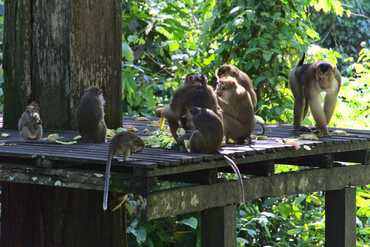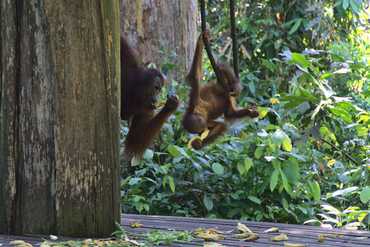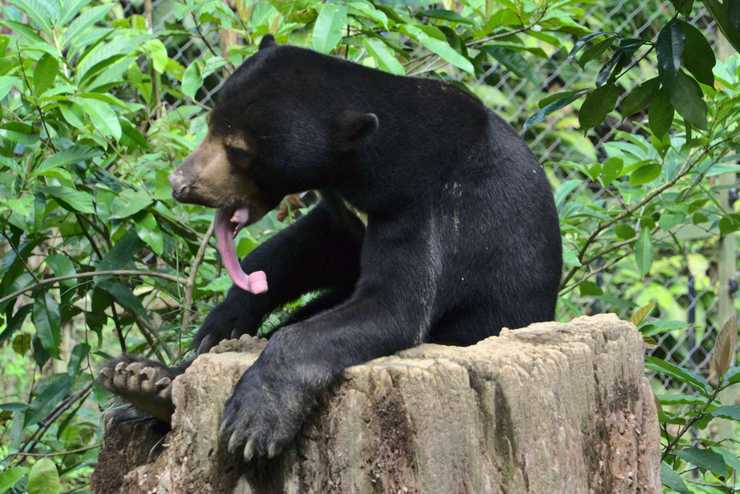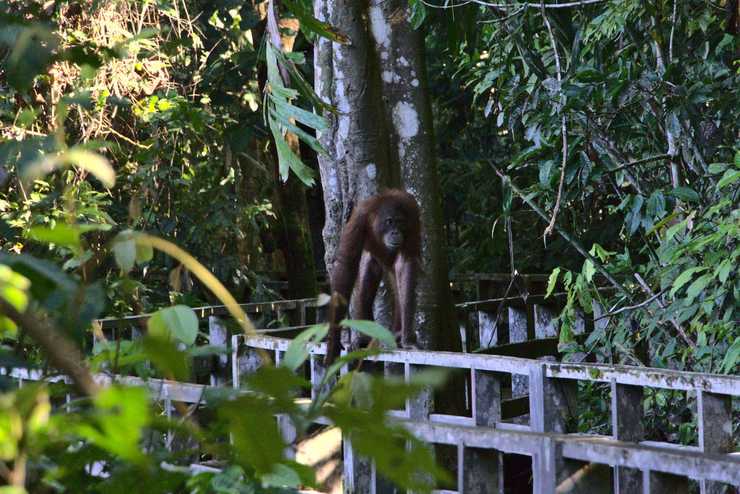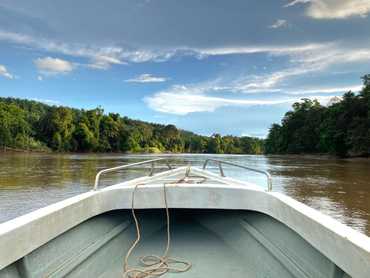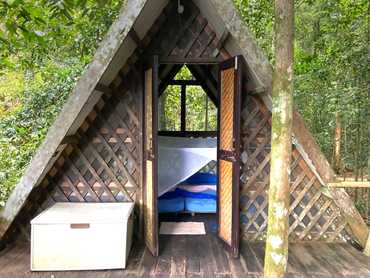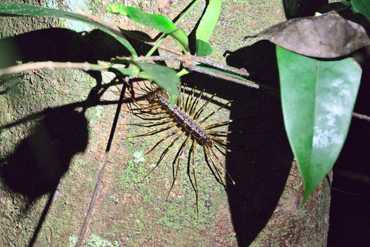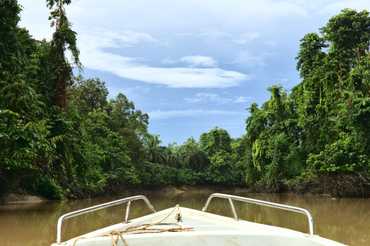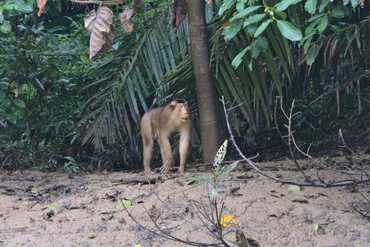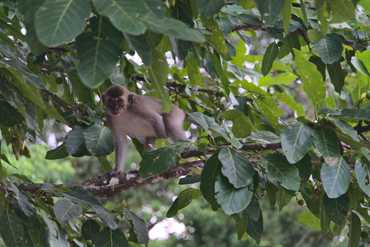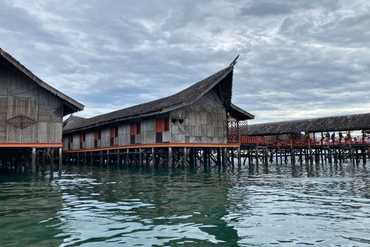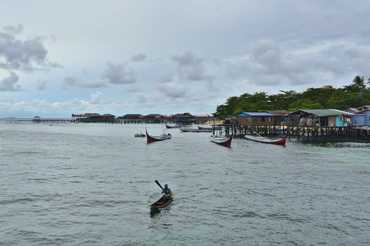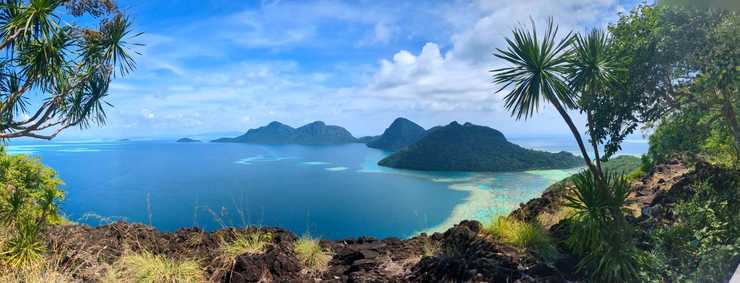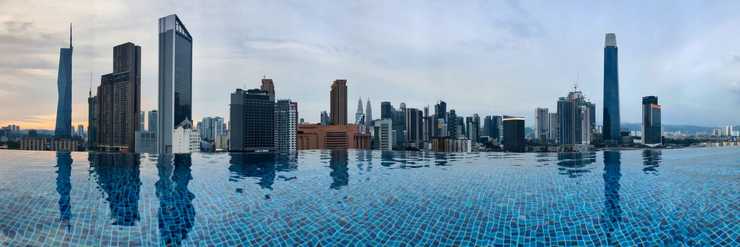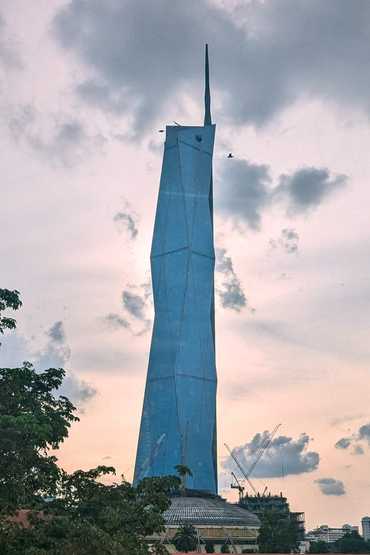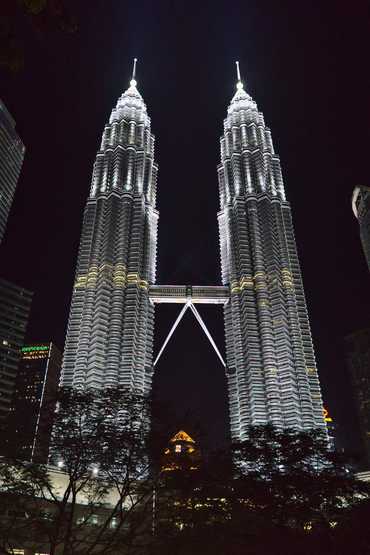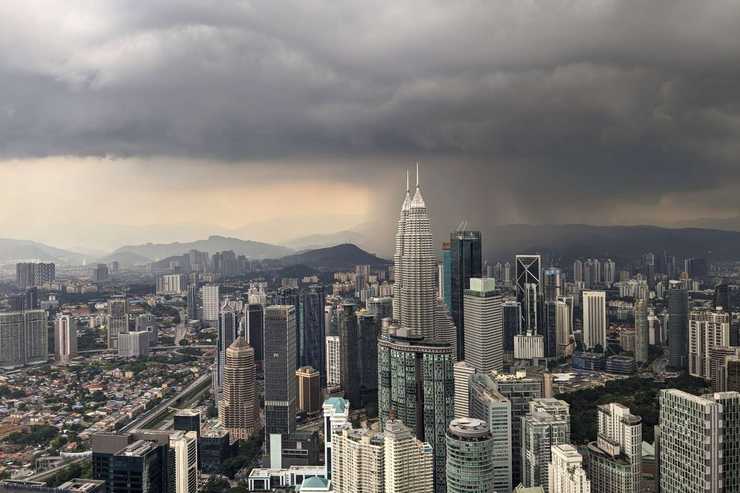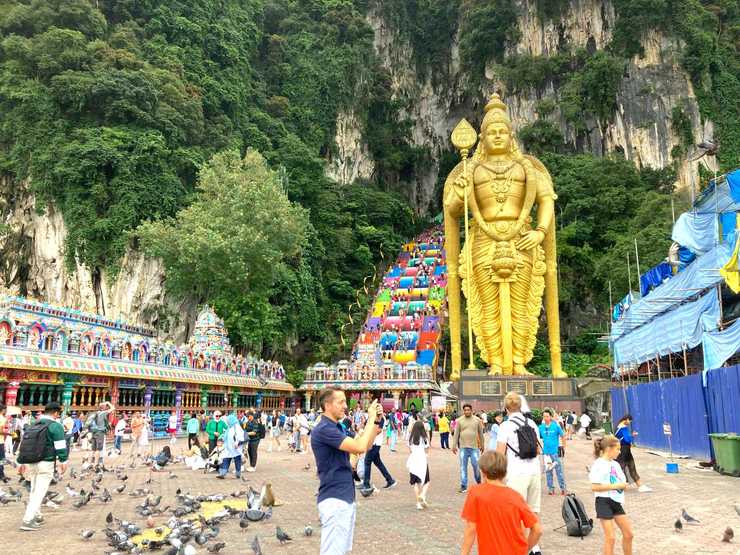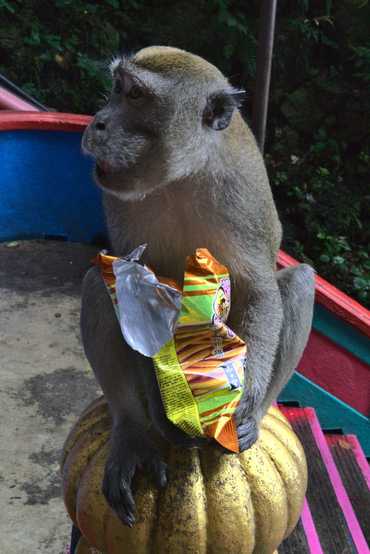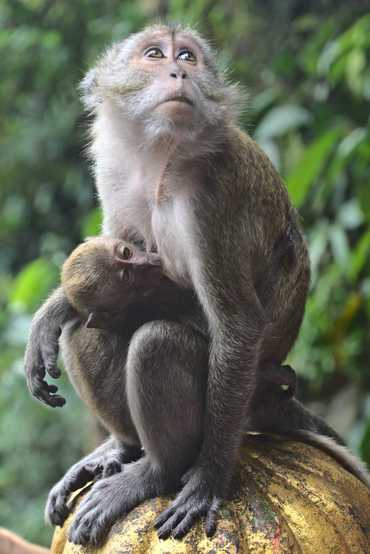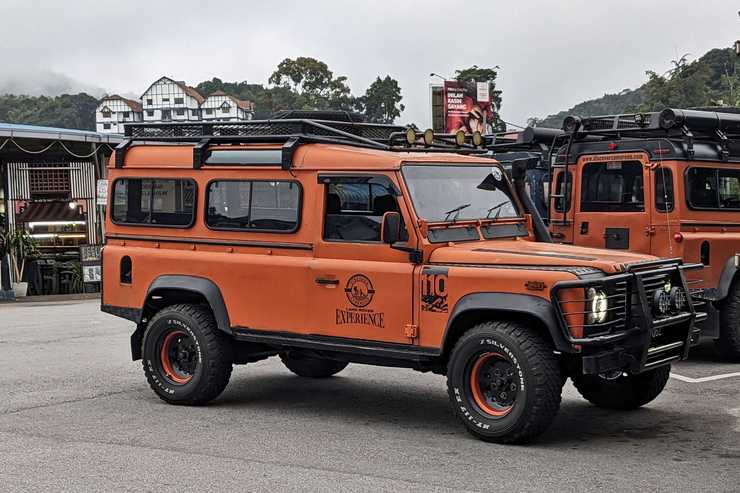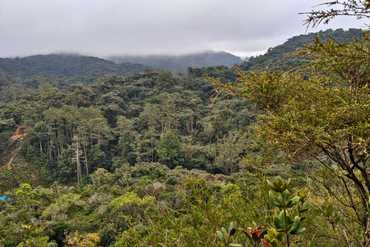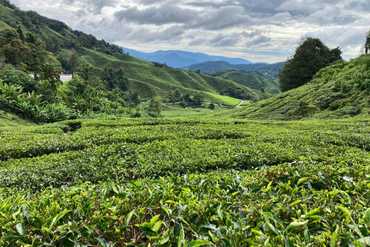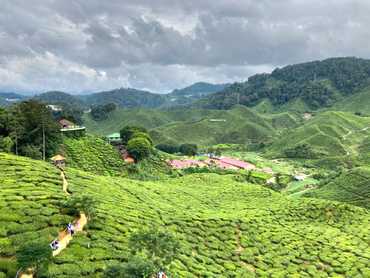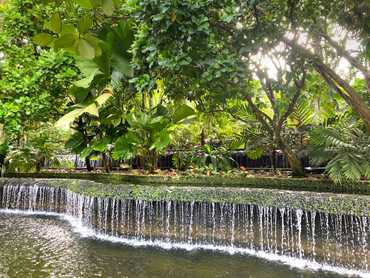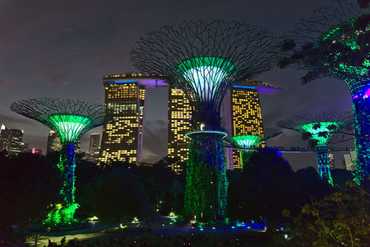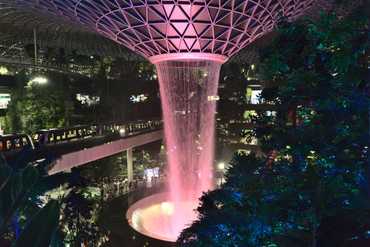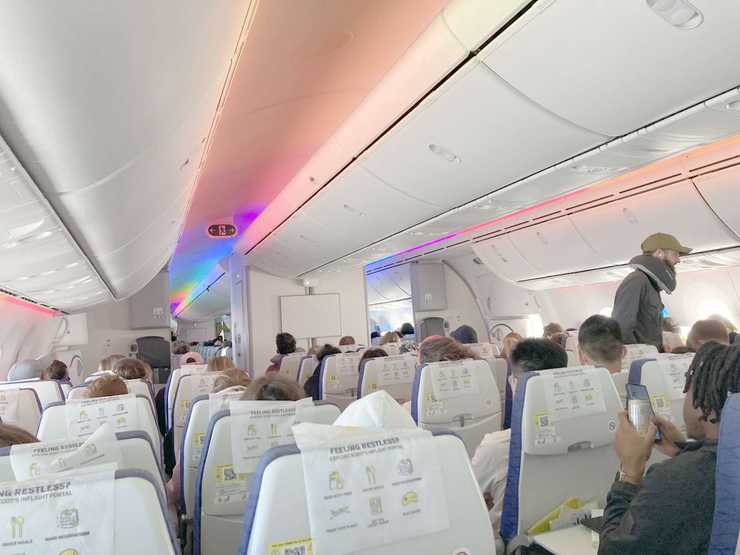Malaysia, Borneo and Singapore with a backpack
- Where and why
- Singapore
- Borneo, Kota Kinabalu
- Borneo, Sandakan
- Kinabatangan
- Semporna
- Kuala Lumpur
- Cameron Highlands
- Johor Bahru and crossing the border to Singapore
- Singapore (again)
- How much
- Summary
Where and why
I’ve been wanting to go somewhere far away for a while now, but my plans were somewhat thwarted by Covid and its limitations. Fortunately, that’s gone now, so at the beginning of 2023 we started thinking about going to more distant lands. It was clear from the start that we were limited by dates - we could go in July or August - not the ideal time for many countries. Weeks went by, lots of other worries on top of that. But finally, in early April, we had a list of several countries (Peru, Vietnam, Malaysia). We couldn’t find reasonable flights to Peru, but we did manage to find a good direct flight Berlin - Singapore, which narrowed down the options a bit. And the preference for reasonable civilisation, availibility of public transport and the uncertainty about the weather in Vietnam made the final decision - we will fly to Singapore and then on to Malaysia. In early April (3 months in advance) we bought our tickets to Singapore and started looking forward to it.
Malaysia is a former British colony, which has the advantage of a general knowledge of English. Another language used is Malay. We made an attempt to learn at least the basic phrases, but didn’t need them at all (except perhaps thank you). Malay (similar to Indonesian) uses the same characters and has a very simple grammar (no verb conjugation or timing), but the words are of course completely different from European languages.
While reading travel diaries about Malaysia[1][2][3] we were immediately drawn to Borneo. The pictures of the sea looked beautiful and the rainforest is also not something you see in Europe. We had 3 weeks, which we thought was enough for Singapore, Borneo and mainland Malaysia. A more detailed plan showed that we would only catch part of Borneo (Sabah state) and only Cameron Highlands in mainland Malaysia (and we would have to skip Taman Negara park - but we would enjoy enough rainforest in Borneo anyway). We also took inspiration from the organised tour operators’ itineraries when planning (it’s a good inspiration, but we like doing it on our own + we felt we could do it significantly cheaper).
Our final itinerary was roughly:
- 1 day in Singapore
- 2 days in Kota Kinabalu - Tunku Abdul Rahman Marine Park
- 3 days in Sandakan - Sepilok Reserve + Buddhist temples in the city + trip to Kinabatangan River
- 4 days in Semporna - a dirt hole but with beautiful islands for diving/snorkeling
- 2 days in Kuala Lumpur
- 3 days in Cameron Highlands
- 1 day in/near Singapore
In mid-May we bought tickets for local flights from Singapore to Kota Kinabalu, from Kota Kinabalu to Sandakan and from Tawau to Kuala Lumpur. We decided to handle the remaining transfers locally by bus. We also preferred to book our accommodation about a month in advance via Booking.com or Airbnb - July is high season in Malaysia, we didn’t want to be caught off guard by problems finding accommodation on the spot.
After consulting with the doctors, we rather got vaccinated against rabies (3 doses) and typhoid. Unfortunately, the part of Borneo we wanted to go to is a malarial area, so we were advised to take prophylactic anti-malarials (during out stay in the malarial area and for a few days before and after).
Packing was a bit more complicated, we didn’t want to carry too much or forget anything. We both had to pack under 10 kg, we didn’t want to have a checked luggage (and carry it with us all the time afterwards). We mostly packed mainly light synthetic clothes because of the humidity, nothing made from cotton (it’s a problem to dry it).
And on the morning of July 5, 2023, we boarded the plane at Berlin-Brandenburg Airport.
Singapore
After a twelve-hour flight we landed in Singapore. We were pretty sleep deprived. Although we had changed our watches on the plane, the internal clock did not adjust so easily. With a pre-filled digital arrival form, we easily cleared passport control into Singapore (fast lane for chip passports - EU passports among others) and set off to explore the airport - often rated the best in the world. Well, maybe at normal hours it is, but at 5am there’s hardly anything open. The need for food and coffee was satisfied by a stall (one of the few open) selling toast with kaya (coconut jam), coffee and soft-boiled eggs in a cup. Our first time having kaya, it was great! The airport building also has an artificial waterfall and rainforest inside (Jewel building) - unfortunately the waterfall also has opening hours 10 - 22 and outside of that the water doesn’t fall. But we did see the rainforest while waiting for sunrise (around 7) and it’s really quite believable, including the smell.
At the airport we tried to get a SIM card from M1 operator for S$14 which was supposed to have roaming in Malaysia. Unfortunately you can’t get this card at the airport, although the SIM card shops are there and offer M1 operator cards, only the expensive tourist packages. We didn’t want that, so for Singapore we bought an eSIM with 1 GB of data through the Nomad app (for $4 $) and decided to deal with the Malaysian card when in Malaysia.
From the airport, we took the metro (named SMRT - Singapore Mass Rapid Transport) to downtown Singapore, to Gardens by the Bay. In Singapore, you can pay public transport fares by credit card - swipe it at the turnstile at the entrance and exit, no need to shop around. Immediately upon exiting the air-conditioned metro, the local climate assaulted us - hot, muggy, humid and rainy. Fortunately, the rain soon stopped, but the muggy humidity followed us the rest of the trip.
Gardens by the Bay is a park of artificial trees, iron structures gradually overgrown with plants. We got there around 9, which was quite lucky because we were one of the first ones there and could walk through the gardens without people or lines. You can climb up one of the trees (Supertree Observatory), which offers nice views of the sea, the modern office district and the famous Marina Bay Sands hotel building (we still went back to Gardens by the Bay on the evening of the last day of our trip and there were crowds, arriving early in the morning was unknowingly a big luck).
From Gardens by the Bay, we walked past the ArtScience Museum to the modern office district, where we ate at one of the local hawker centres. The hawker centre is a building full of tables and small stalls offering all sorts of food. It was one of our tips on where to eat cheaply in Singapore.
After the meal we were pretty much tired, so we just walked past the Merlion (the white lion statue, the symbol of Singapore) and headed to the hotel, where we fell asleep pretty much immediately after check-in. We slept (with a short dinner break) until the next day. There was plenty of sleep to be catch up.
The hotel had a tiny room with a bed and a mini bathroom next door. We picked a cheaper one, but it was still the most expensive one we’ve stayed in in Asia (about 80 EUR/room/night). Singapore is expensive, in Malaysia the accommodation came out to about a quarter of that. Quite common in Singapore are hotels/hostels where you only have a sleeping capsule, these are a bit cheaper - we didn’t want to do that the first night, we were afraid of the noise, we wanted to sleep after the flight.
The next morning we headed back to Singapore Changi airport for our flight to Kota Kinabalu.
Borneo, Kota Kinabalu
The Air Asia flight to KK was over lunch, so we ordered a hot meal on board (AirAsia has pretty decent and cheap food on board - as we read in reviews and can confirm). The flight was supposed to take 2 hours, unfortunately it didn’t - due to bad weather we couldn’t land and circled over the sea at the destination airport for several hours. Then the pilot decided to land at the alternate airport in Miri for refueling. We waited there for another hour or so and then finally flew to Kota Kinabalu. After sunset, after 7 hours or so.

At the airport we got SIM cards from Celcom (which was supposed to have the best coverage in Borneo). Even the SIM card shop at Borneo’s largest airport didn’t allow us to pay by card, so we figured what to expect from the next few weeks regarding paying by card.
We headed straight from the airport to the hotel (a taxi from the Grab app for about 6 MYR - about 1 EUR). The hotel was a bit secluded, we didn’t go to the city center, we just went to the Chinese restaurant next door for a meal (quick noodles and shrimp - we didn’t mind the noodles so far) and went to bed.
The next day after waking up, we went to the hotel breakfast (which was one of the few the hotel had). To our disappointment (we like sweet breakfasts), breakfast was noodles again, this time with chicken. No choice. Not quite our idea of breakfast, we talked it down to at least a vegetarian version - noodles without meat. It was filling, but still not the best breakfast of our lives.
After breakfast, we let Grab take us to the pier (Jesselton Point) in Kota Kinabalu, where boats leave for the Tunku Abdul Rahman marine park.
We had read about the park beforehand, but we were a bit surprised by the organization of the boat trips. All boat transfers have to be chosen directly at the ticket office in the building behind the entrance to the pier. They will straight away assign you a boat and times when it will come for you and move you to the next island. My original idea of being taken to one island and then possibly to the next island at will didn’t quite work. So we quickly decided on 2 islands at the ticket counter - Gaia and Manukan.
Gaia Island is the largest of the islands in the park and it took about 15 minutes to reach it by speedboat. The boat was bouncing nicely on the waves. We had read about the different beaches on Gaia Island, but we didn’t get to choose one, they took us to Padang Point - a small beach with a pier and a few buildings. We found in the visitor book that there was another Czech here the day before us - our little nation is just everywhere 😀 . The beach was quiet, it was sandy and gradual, so we stayed there for a couple of hours of swimming. We had the idea to cross the island to the opposite side, where the popular Police Beach is - but the plan (stupid from the start - over 1 km through the jungle in sandals) backfired after a lizard more than a meter long ran across our path after a few steps. We later found out that it was a varanus (Asian water monitor) and doesn’t eat people (very often), but our courage to walk left us anyway. So we dutifully waited for the boat, which after a few hours took us to the next island.
Manukan Island was completely different, with many more people, several restaurants and tourist facilities. We retired to the more secluded edge of the beach, swam in the warm sea and rested contentedly until the time of our boat’s departure. In the afternoon, there were a lot of people trying to get off the island, so there was quite a queue on the pier and we had to stand in the sun for quite a while. Luckily we used sunscrean that time, but the almost equatorial sun still burned us a bit.
After we got back we had a fruit smoothie (mango/pitaya with coconut milk - yum!) on the pier in Kota Kinabalu, walked around the town a bit and finally had a fish dinner at Glam’ Fresh Seafood - highly recommended - there was a bit of a problem with communication, but our hands and pointing helped and we got a really great dinner for less than 30 MYR (about 5.5 EUR).
After a tiring day in the sun, we were happy to go to bed, get some sleep before our half-hour flight to Sandakan (we just hoped it would actually be half an hour this time). We had some qualms about not taking the greener option - bus, but 12 hours (a whole day of vacation lost) versus a half hour flight was just the obvious choice - especially when the price was basically the same.
Borneo, Sandakan
Fortunately, the flight in the morning went fine and after less than half an hour we landed in Sandakan. At the airport we were wondering where to go next - either to the city or to Labuk Bay Proboscis Monkey Sanctuary. The airport is almost in the middle between these two options. In the end, after reading the reviews, we decided not to go to Labuk Bay - it is the most expensive of all the reserves and we didn’t want to support the business (it seems to be a spin-off of the owner of the oil palm farm next door, who has driven the monkeys out of their original homes and into the reserve). We had plans for another monkey sanctuary in Sandakan, so we decided to skip this one and continue into town.
In Sandakan, we took a Grab to the Buddhist temple of Hong San Tze. For us, this was one of the first Buddhist temples we visited - we admired the natural motifs of the decorations (instead of the suffering motifs in Christian temples). We waved at a local minibus on our way to the city centre. We didn’t understand a word, and neither did they, but it was going in the right direction and fortunately it really was going to the city centre. There was a paper in the minibus with a price chart which we didn’t understand, but on getting off we gave the driver 1 MYR each and he seemed happy.
What we found interesting about the centre of Sandakan is that there are shrines of almost all religions right next to each other - a Christian (Anglican) church, a Taoist temple, several Buddhist temples and mosques. And so many religions in one place doesn’t seem to cause friction. People were laughing, and Muslim women were taking pictures at the Christian church (St. Michael’s and All Angels Church), all veiled up. I guess white tourists are not very frequent visitors, so they needed to take a picture with us as well.
Unfortunately, Sandakan and the Kinabatangan River, where we were heading next, is a malarial area, so we put on anti-malarials beforehand just in case, as recommended by our doctor (1 pill a day). We also used repellent quite a bit, which elicited amused smiles from the locals. In hindsight, the worries were probably unnecessary, we didn’t encounter many mosquitoes either, but we weren’t sure and didn’t want to leave it to chance.
Sandakan also experienced some rather unpleasant events during World War II, so a lot of the local sights revolve around them. We avoided those, though.
In Sandakan we chose accommodation in the Sim-Sim water village north of the centre. It’s basically an awful lot of little huts on stilts with bridges between them - we wanted to try local living, not a hotel that looks the same everywhere. The accommodation (via AirBnb) was great, the cabin was comfortable and clean, with electricity and air conditioning in the room. The only thing that bothered us was the amount of rubbish in the sea. There was a leaflet in the accommodation explaining that the waste was mainly there because of the sea currents that bring it in. Unfortunately this is not the whole truth, we often saw the natives throwing waste into the sea, rubbish bins and waste collection is basically an unknown thing here. Malaysia is one of the biggest polluters of the ocean and it shows in Borneo’s less touristy towns. We also learned later that even if they do collect the waste, there’s nowhere to take it - there are no places to process waste in Malaysian Borneo and it’s not worth taking it elsewhere by sea.
Apart from the environmental problem (and the smell it causes), the water village is very nice and has a number of restaurants, mostly for locals. We had very good seafood at one of them.
The next day in Sandakan we had 3 reservations planned - Orangutan Sanctuary Sepilok, Bornean Sun Bear Conservation Centre and Rainforest Discovery Center. They are all in Sepilok, a short distance from each other but about 25 km from Sandakan. So in the morning we took a Grab to get there, for about 30 MYR (about 5.5 EUR). Entrance to the orangutan reserve is also 30 MYR. We arrived in time to catch their feeding from 10:00.
From the entrance, it’s about a 500 meter walk on wooden footbridges through the rainforest to the feeding area. The orangutans are shy and hide in the forest until a man appears with a bucket and dumps out fruit. The orangutans and macaques then share the feeding (sometimes they have a good fight over the juiciest piece of fruit). Seeing orangutans in their natural habitat is an amazing experience. Unfortunately, there are very few of them in the wild and they are critically endangered. Orangutans need a large living space (which is disappearing due to the replacement of the rainforest by oil palms) and to raise their offspring they need to survive for a long time, orangutan babies depend on parental care for the first few years of their lives. The Sepilok Reserve often cares for orphaned or injured orangutans and consists of a relatively large piece of the rainforest, with only a small part open to visitors.
The Bornean Sun Bear Centre is just opposite the entrance to the orangutans. Entrance is 50 MYR (approx. 9 EUR). This sanctuary seeks to protect the Malayan bear - the smallest of the rainforest bears that can climb trees. These bears are kept as pets by some keepers - until they grow up and become unmanageable. Then they try to get rid of them. Reserves are trying to get them and save them. Our favourite sight was a yawning bear lying on the remains of a tree trunk. The visitor trails are quite short, much of it inaccessible, how many bears can be seen depends on a bit of luck.
The Rainforest Discovery Center is about 1 km from both reserves. Admission is only 7 MYR (approx. 1.2 EUR), but the space you can walk through is the largest of all the reserves. It has various bridges and towers in the treetops of the rainforest. It is especially famous for bird watching. Unfortunately we didn’t see many, it was almost noon and probably too hot for the birds (and for us when we climbed the towers). But that was mostly our bad timing, I guess you can see a lot in the morning or on a night walk. But still a very nice walk during the day accompanied by the sounds of the forest.
When we came out of the reserve, we figured we could catch the second orangutan feeding at 3pm. Being good Czechs, we noticed that the ticket only has the date, but not the time, and the ticket is not validated in any way. So we went back to the orangutans and went to watch the feeding one more time (and take hundreds more photos). This time the orangutan mother and her baby came along.
We were almost the last ones left in the reserve. On the way back to the entrance, an orangutan emerged from the rainforest onto the road and seemed intrigued by my camera. At first I excitedly snapped a photo, but was soon startled by how close it was. The orangutan has tremendous strength and can be dangerous (signs in the reserve recommend staying at least a few metres away). Luckily nothing happened, the orangutan followed us a short way along the footbridges and then disappeared into the rainforest.
We took a taxi back from Sepilok (one of the taxi drivers who was standing outside the reserve took us). On the way we stopped to buy tickets for the next day at the bus station (the taxi driver offered to take us, but we didn’t want to). We bought a ticket to Lahad Datu for 40 MYR (about 7 EUR), but planned to ask the driver to stop about halfway, at the Kinabatangan River.
Kinabatangan
We left Sandakan in the morning by bus to Lahad Datu. The bus was surprisingly very comfortable, air-conditioned and generally adapted for the long journey. The bus also had a steward, to whom we pointed out several times that we wanted to get off at Kopel Junction. After about 2 hours of driving, our bus actually stopped at Kopel Junction, just before the bridge over the Kinabatangan River. We walked down a side road past a local school to the KOPEL visitor center.
KOPEL is a local initiative that runs an eco-camp on the Kinabatangan River (Tungog Rainforest Eco Camp). I had already researched this place back home and arranged the stay. It offers several programs of staying in cabins in the rainforest, we chose the shortest one - 1 night in a cabin + several excursions around the camp.The longer programs also offer tours of more remote places, or the opportunity to help with reforestation. This is because the initiative is trying to restore the forest around the river, often unfortunately replaced by oil palm farms. There are other accommodation options by the river, often more luxurious (these are really just cabins, without electricity), but they are purely commercial.
After the check-in at KOPEL, our guide Adam came to us and explained what will we do. We had a river trip to the eco-camp, a few walks around the camp and an evening and morning boat ride. We were to sleep in a cabin in the middle of the rainforest. We were expecting to be in a larger group, but it was just the two of us (we met other groups at the camp, with different guides, and also a group of English students who had come to volunteer on ecological programs). We got our rubber boots, and life jackets, got into the boat with Adam and headed downstream. The Kinabatangan River is completely brown from the mud that washes down its long course through Borneo. The boat ride to the campsite took a short 10 minutes. From the boat, it’s still a few hundred metres to the huts, along paths in the rainforest.
Immediately upon arrival we saw monkeys on the branches of the trees. And a bent metal sign pointing to the camp (bent by pygmy elephants, according to our guide). We locked our backpacks in an iron box at the campsite so that something wouldn’t take and eat them. In the evening we went to the river where we saw various species of monkeys, birds around the river and a baby crocodile in the river (we didn’t see a proper crocodile until the next morning). We still had a night walk through the rainforest after dark, which is quite an intense experience. On our return it started to rain heavily, we ran the last 200 meters to the lodge, but still finished completely wet. There was a terrible thunderstorm at night, which doesn’t feel exactly safe in the rainforest in a small wooden hut with no electricity and no mobile signal.
The next day we took another ride on the river at dawn, where we saw a big crocodile (it is not recommended to fall into the river) and a flock of monkeys moving along the river. We saw the rainforest one more time, during the day. Unfortunately, we didn’t see elephants (only their poop), but even so, movement in the rainforest was something very unusual for a Central European. The omnipresent humidity and heat is unfortunately also quite intense for a Central European, fortunately there are showers at the lodges.
After a walk in the rainforest, around noon, Adam took us by boat back to the visitor center. Overall, our stay at Tungog Rainforest Eco Camp was very intense and allowed us to experience the rainforest up close. And our guide was very friendly and nice. In fact, all the locals we met during our trip were nice.
We hadn’t really planned our journey from the camp. We intended to get to Lahad Datu and then to Semporna, with the vague plan of hitching a ride on someone. Our guide, Adam, drove us across the bridge (twice, even, once we had to go back to the reception where we forgot our passports) where there were a couple of restaurants and a better place to hitchhike overall. The drivers smiled at us, but no one stopped for the first few minutes. After a while a white van stopped (and when asked “Lahad Datu?” the driver nodded), but as we soon realized, it was an unofficial local minibus, with locals getting on and off along the way. It took us all the way to Lahad Datu, but it wasn’t a free ride, it cost us 60 MYR (about 11 EUR) per person, which is quite expensive by local standards. In Lahad Datu we bought a ticket to Semporna for 30 MYR (approx 6 EUR) and waited for the bus. It arrived, but with a big delay (as they explained to us, it’s a bus that goes all the way from Kota Kinabalu, about 16 hours, so the departure times are really only approximate). We made the wait more pleasant in an air-conditioned restaurant opposite the bus station.
We arrived in Semporna after dark, we stayed outside the centre in a small hotel called RTMS Guesthouse (we had read that the town center is a dirty dump, which we can confirm - it didn’t seem dangerous to us though). The rooms at the hotel were very basic but really cheap (room about 12 EUR/night) and with a very helpful host who helped us arrange excursions for the next days and drove us to the pier in the morning.
Semporna
There is almost nothing to do on your own in Semporna, you have to arrange day boat trips to the islands. There are basically 3 options - Mabul + Kapalai islands, Tun Sakaran Marine Park (Bohey Dulang viewpoint + nearby islands) and Mataking + Timba Timba + Pandanan islands. It is possible to either dive or snorkel. Tourism is aimed at the Chinese, who are the most frequent visitors. There are plenty of agencies in town that offer tours, but there’s no point in picking up the right one - they offer the same tours pretty much everywhere, for the same price, and run the same type of boats. The trips cost around 160 MYR (approx 30 EUR) per person (snorkeling), diving (with equipment rental) then around 350 MYR (approx 64 EUR).
We chose to snorkel off the islands of Mabul and Kapalai on our first day. The islands are quite far away, the trip takes about an hour by fast motor boat (nothing for people suffering from seasickness). When you arrive at the islands, you can jump into the water (goggles and other equipment were provided to us). The sea (Celebes) is really beautiful, great visibility underwater and lots of colourful corals. We really enjoyed the snorkeling. Lunch is included in the trip and you can spend the remaining time in the sea. We spent several hours there.
But here is where I made a mistake that I regretted the next day. Because it was under a cloud, I didn’t pay much attention to using a sunscrean. Unfortunately, the sun burns a lot almost at the equator, even when it seems to be cloudy. I was sick and had chills when I got back. Looking into a mirror showed that my back was completely burned and I couldn’t touch it. I didn’t sleep much last night (even with the paracene), took several cold showers and back rubs, drank several liters of water. The next morning I was still not feeling well and we had to cancel our planned trip to Mataking + Timba Timba Island. We spent the whole day in bed, me lying on my stomach. Fortunately, by the evening my heat stroke/swimming had improved significantly.
On the third day we went on a trip to the Tun Sakaran marine park. The boat trip again takes about an hour and drops you off at the bottom of the hill on Bohey Dulang Island. The uphill walk is in a bad shape due to frequent rains, you need to have sturdy shoes (or rent them down there, but you’ll definitely do better in your own). The guards at the bottom check the shoes and don’t let you go up without sturdy shoes. The view from the top is really breathtaking though, the sea with several shades of blue and the islands around. We took hundreds more photos. Next, the trip continued to the low sandy islands nearby, which really look like paradise (if only the crowds weren’t there). On this trip there is not so much to see under the sea, more above it, the views were amazing, but snorkeling and seeing interesting places underwater was not as great as the first day (and the lunch - chicken with rice in a box - really wasn’t that great).
We said goodbye to Semporna after this trip. Our host helped us book a minibus for the morning, for the trip to the airport in Tawau. And from Tawau we flew to mainland Malaysia, to Kuala Lumpur.
Kuala Lumpur
The flight to Kuala Lumpur (KLIA) was uneventful and soon we were waiting at KLIA for the bus to the city centre. From the airport you can also get to the centre by direct train (KLIA Ekspres), but it’s quite expensive - 55 MYR (approx 9 EUR), the bus costs 10 MYR (approx 2 EUR). The bus to KL Sentral is not that much slower (approx 1h vs 39 minutes), but you have to wait for it, it runs every half hour (and the nearest one is typically fully booked).
We bought public transport cards for KL Sentral (Touch n Go). We looked for one at the airport but to no avail. You preload some credit on the card (we got I think 20 MYR and it was enough for 2 days) and then you just use it on the turnstile. Kuala Lumpur is a big and busy metropolis, lots of cars everywhere and permanent traffic jams. The city is not very pedestrian friendly, we had trouble finding a crossing over a busy road several times and once used a bus just to get across a large intersection that had no crosswalk anywhere in sight.
In Kuala Lumpur we stayed in an AirBnB with a rooftop pool. Definitely a must try, the accommodation is cheap and the view of a city while swimming in the pool doesn’t come up that often. After we had enjoyed the view enough (and took lots of pictures) and got something to eat, we went to see the Petronas Tower, one of the symbols of Kuala Lumpur. The illuminated towers are really impressive at night, with a nice view from KLCC Park and a water light show underneath (just beware, the KLCC park closes at 10pm).
The second day in Kuala Lumpur we made rather relaxing and did some maintanance, we washed clothes dirty from Borneo. And we went to see KL Tower (Menara Kuala Lumpur). Due to an impending thunderstorm, only the Observation Deck (glassed-in observation deck at 276 meters) was open, the Sky Deck (open observation deck a little higher up) was not. However, even from 276 meters the view of the city covered by storm clouds was very nice. We also had to try the Malaysian national dish Nasi Lemak (rice cooked in coconut milk, wrapped in a banana leaf with egg, anchovies and a very spicy sambal paste) in KL.
On our third day in Kuala Lumpur, we went to Batu Caves. The Batu Caves are a complex of Hindu temples built into a cave, accessed by a series of colourful steps and guarded by a giant statue of the Hindu god Morugan. The Batu Caves are in the north of the city, quite far from the centre, over an hour and a half by public transport. We rather took Grab, which takes about half an hour. To be honest we weren’t completely blown away by Batu Caves, the crowds and littered garbage kind of spoiled it. Plus they make the women at the bottom of the stairs cover their knees and shoulders, without this they are not allowed to enter (no such requirements for men). Probably the best part were the monkeys that stand guard at the stairs and steal food from inattentive visitors (they stole our chips tucked into the outer pocket of our backpack).
On the way from Batu Caves we ate and continued to the bus station (TBS) where the bus to Cameron Highlands left. We boarded and in the evening, after about 4 hours, got off at Tanah Rata, a sort of hub of the Cameron Highlands area.
Cameron Highlands
In Cameron Highlands we had originally planned to do mostly hiking. There would be around 10 different and varying lengths of trails around the village of Tanah Rata, some between tea plantations, which we definitely wanted to see.
After waking up on the first day, we headed to a local place called Yong Teng Cafe for breakfast, where they had great pancakes and coffee, literally for pennies. The cafe was run by a couple of very nice deaf old couple, ordering was done by pointing at the menu and smiles replaced the thank you’s. We went there every day after that.
After breakfast we wanted to go on a trip. We arrived at the beginning of trail 5, but unfortunately we found that the trail was overgrown and basically impassable. After a hundred meters we gave up and turned back. We weren’t the only ones looking for the trail and not finding it. Unfortunately, the information on the routes around Tanah Rata is apparently out of date and (at least some) of the routes are not viable. We checked out Tanah Rata and, after weighing our options, booked a half-day organised jeep tour of Mossy Forest and the Boh tea plantations for the next day (for about 60 MYR - about 12 EUR). There are lots of companies in town offering tours and as far as we know they are all more or less the same. There is also a whole-day option with a butterfly and strawberry farm, but we didn’t care for that, we know butterflies and strawberries from home.
The jeep tour was a good idea, the jeep really comes in handy in Cameron Highlands, the roads are in terrible condition. First we visited a patch of Mossy Forest (it didn’t have the rainforest feel of Borneo, but the guide’s explanation of the plants was interesting). And then Boh Tea Plantation - a tea plantation and historic tea processing factory. Walking in the fields of tea trees was another thing we don’t know from Europe. We tried the teas produced there in the cafe (and bought some as souvenirs to take home). And the jeep took us back to Tanah Rata. We had a quick lunch at an Indian restaurant and visited the Cameron Valley tea plantation near Tanah Rata again, this time by taxi. We walked among the tea trees on our own and tried the tea with durian (I didn’t like it). Considering the amount of visitors, it seemed to us that the plantation lives more from tourism than from selling tea nowadays…
Johor Bahru and crossing the border to Singapore
Our holiday was coming to an end, from Cameron Highlands we were heading back to Singapore - by bus to Kuala Lumpur and then by another bus to Johor Bahru, the last Malaysian city before Singapore. We spent almost a full day on the road, and except for a lot of time, the Malaysian buses were quite comfortable. We arrived in Johor Bahru in the evening, ate and went to the hotel to sleep. We chose to sleep in Johor Bahru because hotels are much cheaper than in Singapore (for a nice hotel even with breakfast we paid under 40 EUR/room/night, in Singapore you can’t get anything for that price). There is nothing touristy in Johor Bahru, tourists don’t even come here or just pass through on their way between Malaysia and Singapore.
Ordering dinner at the restaurant was a bit tricky, there was no English on the menu so we had to use Google translate for it and then order by pointing to individual items. We did get a good dinner though, slightly interrupted by the call to prayer from the mosque across the street.
Breakfast at the better hotel was at least a little bit with choice - they had more than just noodles, even something sweet, pretty close to a continental breakfast 😀 .
Crossing the bridge into Singapore is a bit tricky for pedestrians. Unfortunately, you can’t just cross the bridge as we would have liked. We had to come to the JB CIQ building, walk through the Malaysian side of the border there (and get our passports stamped). Then get a bus to take you across the bridge (for a small fee, but cash only). And then go through the Singapore side of the border - which is quicker if you have a digital arrival form filled out in advance. After checking in, you can proceed again to the already-paid-for bus, which should take you to a major stop in Singapore. However, we must have managed to get out the wrong door and didn’t see the cross-border bus, so we had to continue on Singapore’s normal public transport - which fortunately can be paid for by card.
Singapore (again)
Our last full day in Singapore, our flight didn’t leave until after midnight. We chose a few destinations we missed on the first day - the Botanical Gardens, Chinatown - and again at Gardens by the Bay.
The Botanic Gardens of Singapore is quite a large park with several different sections. The gardens are free to enter (admission is only charged when entering the National Orchid Garden building). The gardens are pleasant to walk through, with lots of plant species and descriptions. In the local heat, the waterfalls and ponds (where you can see water monitors) are a delight.
Chinatown is a maze of small streets with Chinese shops and restaurants. We ate here and visited the largest local Buddhist temple - the Temple of Buddha’s Tooth.
From Chinatown, we moved on (for the second time) to Gardens by the Bay, which we hear is the nicest in the evening, with a light show. The show really didn’t disappoint and the artificial trees illuminated to the beat of the songs, with the famous Marina Bay Sands hotel building in the background will be remembered for a long time. You just have to reckon there will be a lot of people at the show and the crowds leaving afterwards will fill the nearby SMRT stations.
Then it was later in the evening and we left for Singapore Changi Airport. We got there before 10pm and still managed to catch the waterfall in Jewel. After 10pm the airport pretty much dies out again, most of the restaurants and shops close. With our remaining Singapore dollars we bought kaya (coconut jam) which we brought back as a souvenir. We cleared security, boarded the plane… and after another 10 hours we landed in Berlin. Our vacation was over after less than 3 weeks.
How much
We were 2, we traveled 17 days and the trip cost us about 3300 EUR (about 1650 EUR per person). Of which:
- 1800 EUR return ticket Berlin - Singapore (Scoot)
- 200 EUR air tickets Singapore - KK, KK - Sandakan, Tawau - KL (AirAsia)
- 120 EUR all buses and taxis/Grabi
- 400 EUR all accommodation (average about 24EUR/night, most expensive in Singapore - over 80/night, otherwise in Malaysia always under 40/night).
- 360 EUR excursions and entrances (Kinabatangan river, 2 boat trips in Semporna, a trip in Cameron Highlands, entrances to reserves)
- approx. 400 EUR everything else, mostly food, paid in cash
The most expensive was definitely the flight to Singapore and back, which cost more than half the total price. With a bit of luck, you might be able to get a cheaper one by booking more in advance and outside the high season. Then everything is relatively cheap locally, food, local transport and accommodation. The accommodation is fairly decent, although cheap - the facilities were often older but always clean.
In Singapore you could pay for everything with a card, in Malaysia you need cash - we recommend arranging a card that can be used to make cheap withdrawals. We use Revolut, which has almost the best rates anywhere (you can save a few percent compared to normal bank cards), withdrawals have a smaller fee, but it’s still the best option we know of.
Summary
We spent 17 days on our trip to Malaysia, Borneo and Singapore (9 days in Borneo - Sabah province, 6 days in mainland Malaysia and 2 days in Singapore). We like nature more than cities, so we liked Borneo the best. In mainland Malaysia, we spent quite a bit of time in very busy Kuala Lumpur, and we didn’t find Cameron Highlands all that impressive either. Singapore is interesting to see, but again it’s a big and busy city, a few days there seemed quite enough for us.
All the locals we met were very friendly and nice. Communicating in English was mostly fine, with a few places where hands (and Google Translate) helped.
